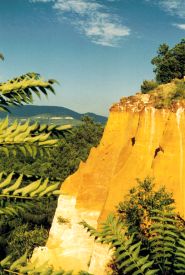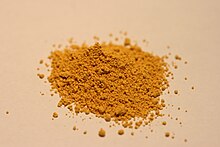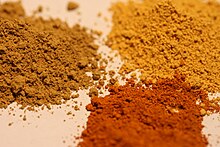ocher
| Ocher (goldenrod) | |
|---|---|
| Components | |
| RGB ( r , g , b ) | (218, 165, 32) |
| Hexadecimal triplet | DAA520 |
Ocher ( Greek ὠχρός ōchrós , German 'pale, pale yellow' ) are earth colors , namely mixtures of 5–20% brown iron stone with clay minerals , quartz and lime .
Use of words
As a pigment , it is considered yellow ocher ( bright yellow ) in different varieties and shades in the painting used, corresponding numbers are red ocher , red ocher or brown ocher , brown ocher . The yellow varieties are based on the hue in light ocher , yellow ocher , gold ocher , meat ocher , satin ocher ( Orange ocher , satin upper divided). When heated, yellow pigments are converted into red and then referred to as burnt ocher . This process corresponds to dehydration of the coloring iron compounds .
“Ocher” is only used as a color name for less saturated yellow tones , especially in contrast to the more reddish siena and the greener umber . Other color names for this shade are natural sienna or Schönbrunn yellow, if used .
As a weave color , the color ocher corresponds to the group called goldenrod ( English " goldenrod ").
Types of paint

Yellow ocher
The natural yellow ocher is named differently according to its origin: French ocher JL (the classic pigment), Terra di Siena ( Italian ocher , Siena earth ), Cyprian ocher (a particularly fine type of light ocher), Bohemian ocher (the actual Schönbrunn yellow ), Derbyshire Ocher , Lusatian Ocher , Amberger Yellow .
The artificial variant and varieties that are embellished with iron oxide yellow are also known as Mars yellow (like iron oxide yellow itself).
The main component of yellow ocher is iron (III) oxide hydrate ( Fe 2 O 3 · n H 2 O - limonite , brown iron stone).
Red ocher
The coloring component in red ocher (related to " red chalk ") is iron (III) oxide hematite ( Fe 2 O 3 ). Typical varieties are French ocher RL, Burgundy ocher , English pit ocher . As with all natural earth pigments, there are also proportions of clays and quartz . The red ocher is also obtained by burning the yellow ocher, as burnt ocher or burnt sienna . The firing process is described under Limonite .
Brown ocher
As brown ocher , less colorful (unsaturated) varieties are called, which therefore appear more brown than with a yellow or red hue. It is a natural occurrence with admixtures mostly of manganese oxides and hydrates , which are close to umber . With goethite or with burnt colorants, these look similar to burnt umber or other slightly colored burnt iron oxide pigments.
A letter code has established itself for French ocher , which describes its quality:
- J - jaune / yellow, R - rouge / red, B - brune / brown
- T - very très
- C - claire / light ( translucent ), F - fonce / dark (more opaque varieties), O - or / golden yellow
- L - lavée / washed, E - extra , S - super
- Examples are
- light ocher JTCLES - in watercolor painting a radiantly beautiful, not too bright yellow
- Gold ocher Joles - a hue that the Baroque Yellow corresponds.
- Other grades of ocher are
- Satin upper or satin ocher refer to the Orange continuous, particularly intensely colored varieties and their imitations.
- Pit ocher or resin ocher , on the other hand, is a basic iron (III) sulfate ,
- Satin Gold top is a commercial grade of yellowish red lead ( Lead (II, IV) oxide ).
use
All ocher can be used in any binding agent after appropriate trituration . As iron oxide pigments, they are absolutely lightfast , weather-resistant and compatible with all other pigments (assuming the necessary purity).

history
Ocher already appeared in the Middle Stone Age of South Africa as a dye to decorate ornamental snails or as body jewelry, also as a complete painting z. B. the North American Beothuk Indians. In the cave paintings of the European Upper Paleolithic ocher was also used. The scattering of red ocher has been a typical feature of tombs from the Gravettian to the Magdalenian .
In ancient times and in the Middle Ages , ocher was part of the basic warm palette of all colored media in the arts.
Extraction
The best known mining site in Europe are the ocher quarries in the French town of Roussillon in the Vaucluse department . The gold ocher with its exquisite color, the typical baroque yellow, was famous for its particularly good quality . An impressive, also abandoned mining area is located about 20 km east of Roussillon in Colorado near Bouvène, south of Rustrel. These deposits were already used in Roman times , later forgotten and only rediscovered in 1780.
The mining and sale of French ocher is managed by the Société des Ocres de France (SOF). In Germany, ocher was primarily extracted from sedimentation basins ("ocher swamps") in Goslar on the northern edge of the Harz, which clarified the pit water from the Rammelsberg mining industry. In the Upper Palatinate, too, ocher was extracted in underground mining near Neukirchen near Sulzbach-Rosenberg until around 1920 . Then it was usually processed into paint in a paint mill there.
A well-known Australian mining area is Wilgie Mia near Perth.
Ocher is still at low levels of earth through lengthy Ausschlämmverfahren won. For this purpose, the pigment is washed out in a series of clarifiers and cleaned of fiber in windmills . This raw material is dried and delivered. If necessary, it is brought to the desired color using a firing process. In addition, particularly beautifully colored “nests” (small, concentrated collections) are used especially for artist and restoration needs.
The vast majority of ocher is artificially made from iron oxide paints and grown on a suitable substrate.
literature
- Ian Watts: Ocher in the Middle Stone Age of southern Africa: ritualized display or hide preservative? In: The South African Archaeological Bulletin. Vol. 57, No. 175, June 2002, ISSN 0038-1969 , pp. 1-14.
- Kurt Wehlte : Materials and techniques of painting. Otto Maier, Ravensburg 1967 (also: English and others, Wiesbaden 2009, ISBN 978-3-86230-003-7 ).
Web links
- Kremer Pigmente GmbH & Co. KG - with comprehensive information on various pigments
- Société des Ocres de France (French)
- Industrial Culture Views - France, Roussillon - The colors of the earth
Individual evidence
- ↑ Burgunder Erden ( Memento of the original dated May 24, 2006 in the Internet Archive ) Info: The archive link was inserted automatically and has not yet been checked. Please check the original and archive link according to the instructions and then remove this notice. . In: Kremer (August 13, 2006).
- ↑ a b yellow ocher and gold ocher ( memento of the original dated November 9, 2006 in the Internet Archive ) Info: The archive link was inserted automatically and has not yet been checked. Please check the original and archive link according to the instructions and then remove this notice. . In: Kremer (August 13, 2006).
- ↑ Margarete Bruns: Of red ocher, pokeweed and purple snails. On the history of the red color. In: Emil Ernst Ploß: A book of old colors. Technology of textile colors in the Middle Ages with an outlook on solid colors. 6th edition Munich 1989, pp. 7-13.
- ↑ a b Red-brown ocher ( Memento of the original from September 3, 2006 in the Internet Archive ) Info: The archive link was inserted automatically and has not yet been checked. Please check the original and archive link according to the instructions and then remove this notice. . In: Kremer (August 13, 2006).
- ↑ a b c d Lit: Wehlte , Ocker p. 92 f., Burned Ocher p. 116 f., Brown Pigments p. 127 ff.
- ^ Erdfarben ( memento of October 20, 2008 in the Internet Archive ). In: Kremer (August 13, 2006).
- ↑ Gruben Ocher ( Memento of the original dated November 10, 2006 in the Internet Archive ) Info: The archive link was inserted automatically and has not yet been checked. Please check the original and archive link according to the instructions and then remove this notice. . In: Kremer (August 18, 2006).
- ↑ Lyn Wadley: Cemented ash as a receptacle or work surface for ocher powder production at Sibudu , South Africa, 58,000 years ago. In: Journal of Archaeological Science 2010 doi: 10.1016 / j.jas.2010.04.012 .
- ↑ a b French ocher ( Memento of the original from September 26, 2006 in the Internet Archive ) Info: The archive link has been inserted automatically and has not yet been checked. Please check the original and archive link according to the instructions and then remove this notice. . In: Kremer (August 13, 2006).
- ↑ Société des Ocres de France: Histoire de l'ocre . (French), accessed on August 13, 2006.








